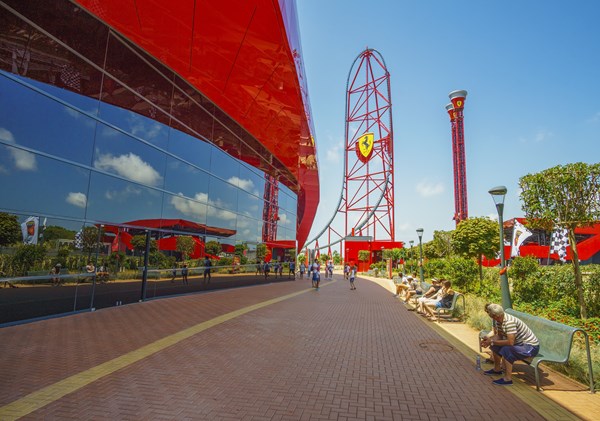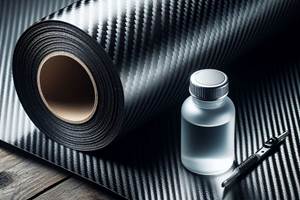Ferrari Land features FRP cladding
A total of 800 individual FRP parts were hand layup molded by specialist architectural façades and parts fabricator Look Composites.
 (1).jpg;maxWidth=600)
Front view of the Ferrari Experience building, with car hood shaped entrance. (Photo credit: Scott Bader).
The Ferrari Land theme park in Spain was officially opened to the public on April 7, which aims to capture the spirit of Ferrari cars. The theme park’s two key landmarks – the Ferrari Experience building with its instantly recognizable classic Ferrari red colored exterior and car hood shaped entrance, and Red Force which is now Europe’s tallest and fastest rollercoaster at over 112 metres tall - were fabricated using a combination of painted flat aluminum panels and more complex, curved FRP composite wall cladding and roofing sections. Altogether, the FRP composite parts supplied covered approximately 1,500 square meters installed on the exterior of the Ferrari Experience building and various sections of the Red Force rollercoaster ride.
A total of 800 individual FRP parts were hand layup molded by specialist architectural façades and parts fabricator Look Composites at its factory in Alicante, in the south east of Spain. All the molded FRP parts were supplied to the contractor ready for priming and painting; as the buildings used both aluminum and FRP cladding panels, to ensure identical color matching of dissimilar material, all the sections were spray painted as a second stage by a specialist local company. The FRP composite panels supplied had to meet the Euroclass B,s2,d0 fire specification stipulated for this construction project.
All of the FRP composite parts needed were custom molded by Look Composites using Scott Bader’s Crestapol 1212 resin with Alumina trihydrate (ATH) fire retardant filler.
The molding phase of the project took Look Composites eight months to complete, with finished molded FRP parts delivered in planned stages to the construction site. The 800-complex shaped composite parts needed were challenging to mold to the size, design and dimensional accuracy required; each FRP part had either a double curvature design, or were non-linear with curves and tight angles, all with molded fixing point flanges.

The first challenge for the Look Composites team was to design and fabricate all the composite tooling for the very wide variety of differently sized and shaped curved parts. Vitally important was the accurate positioning of the molded FRP flanges on each part to ensure that when each wall cladding and roofing section was mechanically fixed onto the building framework, it exactly lined up and fitted into place.
The second challenge was to select a suitable FRP laminating resin that could meet the Euroclass B,s2,d0 fire specification and still be cost effectively hand molded with good levels of shop floor productivity, needed for such a large number of parts.
Developed with processability as a key requirement, Crestapol 1212 resin enables hand layup and infused molded FRP parts or pultruded profiles to be rapidly produced due to a combination of the resin having a very low viscosity with a fast ambient temperature cure rate; depending on the complexity of a part, demolding can take place as soon as the peak exotherm has been reached.
The building designs and specifications for this theme park were developed by Permasteelisa España S.A.U., based in Madrid, which also managed the building construction project. This included handling the production of the aluminum cladding panels, overpainting of the aluminum and FRP parts, and on site installation, working in close cooperation with Look Composites and other specialist subcontract companies engaged on the project.
Related Content
COMPINNOV TP2 project promotes use of thermoplastics in aerospace
Completed in 2023, COMPINNOV TP2 explored thermoplastic composites, enhancing the understanding between prepregs and production methods to foster the potential for French aerospace innovation.
Read MoreComposite resins price change report
CW’s running summary of resin price change announcements from major material suppliers that serve the composites manufacturing industry.
Read MoreInduction heating system enables OOA composites processing
JEC World 2025: Roctool focuses attendees’ attention on the light induction tooling (LIT) system targeting efficiency, sustainability and performance.
Read MoreComposite Integration presents webinar on liquid resin infusion
On July 30, 2025, company experts will discuss the role of LRI in delivering scalable, OOA composite production for the aerospace sector.
Read MoreRead Next
Next-gen fan blades: Hybrid twin RTM, printed sensors, laser shock disassembly
MORPHO project demonstrates blade with 20% faster RTM cure cycle, uses AI-based monitoring for improved maintenance/life cycle management and proves laser shock disassembly for recycling.
Read MoreCeramic matrix composites: Faster, cheaper, higher temperature
New players proliferate, increasing CMC materials and manufacturing capacity, novel processes and automation to meet demand for higher part volumes and performance.
Read MoreUltrasonic welding for in-space manufacturing of CFRTP
Agile Ultrasonics and NASA trial robotic-compatible carbon fiber-reinforced thermoplastic ultrasonic welding technology for space structures.
Read More












